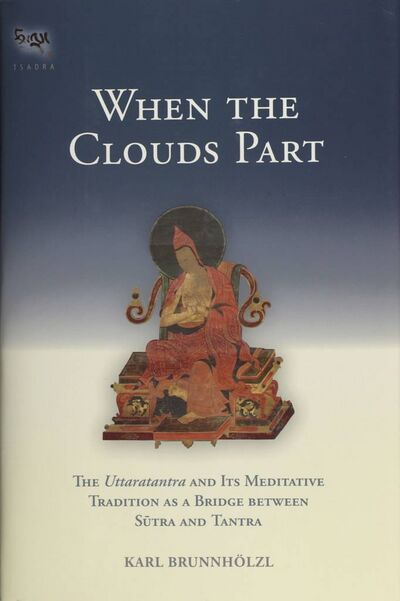When the Clouds Part
| Citation | Brunnhölzl, Karl. When the Clouds Part: The Uttaratantra and Its Meditative Tradition as a Bridge between Sūtra and Tantra. Tsadra Foundation Series. Boston: Snow Lion Publications, 2014. |
|---|---|
- Abbreviationsix
- Prefacexi
- Acknowledgmentsxiii
- Translator's Introduction1
- The Sūtra Sources of the Tathāgatagarbha Teachings3
- Different Ways of Explaining the Meaning of Tathāgatagarbha53
- Explanations of Tathāgatagarbha in Indian Texts54
- Tathāgatagarbha as the Emptiness That Is a Nonimplicative Negation55
- Tathāgatagarbha as Mind’s Luminous Nature57
- Tathāgatagarbha as the Ālaya-Consciousness63
- Tathāgatagarbha as a Sentient Being63
- Tathāgatagarbha as the Dharmakāya, Suchness, the Disposition, and Nonconceptuality64
- Tibetan Assertions on Tathāgatagarbha65
- The History and Transmission of "The Five Dharmas of Maitreya" from
India to Tibet81 - The Mahāyānottaratantra (Ratnagotravibhāga) and the
Ratnagotravibhāgavyākhyā93- Texts and Authorships93
- The Meanings of the Titles Ratnagotravibhāga and
Mahāyānottaratantraśāstra95
- The Uttaratantra and Its Relationship with Yogācāra105
- The Meditative Tradition of the Uttaratantra and Shentong123
- The Two Approaches of Explaining the Uttaratantra123
- The Shentong Lineages and the Meditative Tradition of the
Uttaratantra in the Jonang, Kagyü, and Nyingma Schools131 - Indian Forerunners of Shentong, Early Tibetan Shentongpas, and Their Connection to the Uttaratantra140
- The Uttaratantra and Mahāmudrā151
- Sūtra Mahāmudrā, Tantra Mahāmudrā, and Essence Mahāmudrā151
- The Sūtra Sources of Mahāmudrā165
- Maitrīpa’s Mahāmudrā of "Mental Nonengagement"167
- Connections between Maitrīpa’s Mahāmudrā and the Uttaratantra177
- Other Indian Nontantric Treatises on Mahāmudrā184
- Gampopa’s Mahāmudrā and the Uttaratantra190
- The Third Karmapa, Rangjung Dorje202
- The Eighth Karmapa, Mikyö Dorje206
- Tagpo Dashi Namgyal 212 Padma Karpo214
- The Eighth Situpa, Chökyi Jungné216
- Other Kagyü Masters on Mahāmudrā and the Uttaratantra227
- Gö Lotsāwa’s Unique Mahāmudrā Interpretation of the Uttaratantra243
- The Geden Kagyü Tradition of Mahāmudrā278
- Overview of the Indian and Tibetan Texts Presented in This Book283
- The Uttaratantra and Ratnagotravibhāgavyākhyā283
- The Indian Texts on the Uttaratantra288
- The Tibetan Commentaries301
- Instruction Manuals314
- Translations329
- Ratnagotravibhāga Mahāyānottaratantraśāstra331
- Chapter 1: The Three Jewels and the Tathāgata Heart337
- Chapter 2: Awakening415
- Chapter 3: The Buddha Qualities429
- Chapter 4: Buddha Activity437
- Chapter 5: The Benefit455
- Pith Instructions on "The Treatise on the Ultimate Continuum of the
Mahāyāna" by Sajjana461 - A Commentary on the Meaning of the Words of the "Uttaratantra"473
- A Commentary on "The Treatise on the Ultimate Continuum of the
Mahāyāna," The Heart of the Luminous Sun by Dashi Öser695 - Instructions on "The Ultimate Continuum of the Mahāyāna" by Mönlam
Tsültrim777 - The Repository of Wisdom by Mönlam Tsültrim789
- The Heart of the Matter of Luminosity by Mönlam Tsültrim797
- Pith Instructions on the Wisdom at the Point of Passing when about to
Die by Mönlam Tsültrim801 - The Lamp That Excellently Elucidates the System of the Proponents of Shentong Madhyamaka by the Eighth Karmapa803
- Guiding Instructions on the View of Great Shentong Madhyamaka— Light Rays of the Stainless Vajra Moon by Jamgön Kongtrul831
- Ratnagotravibhāga Mahāyānottaratantraśāstra331
- Appendix 1: Selected Indian and Tibetan Comments on Uttaratantra I.27–2855
- Appendix 2: Selected Indian and Tibetan Comments on Uttaratantra I.154–5901
- Appendix 3: Indian and Tibetan Comments on Abhisamayālaṃkāra V.2943
- Appendix 4: The Emptiness Endowed with All Supreme Aspect953
- Appendix 5: The General Explanation of Tathāgatagarbha in Yeshé Dorje’s Commentary on the Uttaratantra963
- Appendix 6: The Presentation of the Purpose of Teaching Tathāgatagarbha in
Yeshé Dorje’s Commentary on the Uttaratantra969 - Appendix 7: Comparison of the First Six Topics of the Fourth and Fifth Vajra Points in the Uttaratantra with the Same Six Topics in the Mahāyānasūtrā-
laṃkāra and the Mahāyānasaṃgraha979 - Appendix 8: A Letter from Stainless Expanse and Awareness— a Casual
Summary of the "Uttaratantra983 - Notes985
- English–Sanskrit–Tibetan Glossary1227
- Tibetan–Sanskrit–English Glossary1231
- Bibliography1235
- Index1259
When the Clouds Part is a translation and study of the Uttaratantra, also known as the Ratnagotravibhāga, and nine related texts from India and Tibet, some translated for the very first time in this publication. It is not the first translation of the text—Brunnhölzl cites two previous English translations by Obermiller (1931) and Takasaki (1958), who translated from Sanskrit and Tibetan, and Sanskrit, Tibetan, and Chinese, respectively.
The book begins with a 325-page "Translator's Introduction," a study of the sutra's sources and exegetical traditions, which is a tour de force and a major reference for buddha-nature studies. It is for highly educated readers, assuming an extensive familiarity with the issues and terms of the discussion, such as the Madhyamaka/Yogācāra divide and the doctrine of tathāgatagarbha.
The Translator's Introduction is divided into eight sections: (1) the sūtra sources for tathāgatagarbha teachings; (2) historical survey of Indian and Tibetan definitions of tathāgatagarbha; (3) the history of the transmission of the "Five Books of Maitreya" to Tibet; (4) a survey of explanations of the meaning of the title of the Uttaratantra; (5) the relationship between the Uttaratantra and Yogācāra; (6) the Uttaratantra and zhentong; (7) the Uttaratantra and Mahāmudrā; (8) and an outline and summary of the ten works translated.- Maitreya. An Analysis of the Jewel Disposition, A Treatise on the Ultimate Continuum of the Mahāyāna - mahāyānottaratantraśāstra-ratnagotra-vibhāga (theg pa chen po rgyud bla ma'i bstan bcos). (D 4024) sems tsam, phi 54b1-73a7. (Q 5525) sems tsam, phi 54b7-74b6 (vol.108, p.24-32); (N 4293) sems tsam, phi 48b3-69a3. In bstan 'gyur (sde dge), Vol. 123: 107-146. Delhi: delhi karmapae choedhey, gyalwae sungrab partun khang, 1982-1985.

- Sajjana. Pith Instructions on “The Treatise on the Ultimate Continuum of the Mahāyāna” - Mahāyānottaratantraśāstropadeśa. Sanskrit edition in Kano, Kazuo. "rNgog Blo-ldan Shes-rab’s Summary of the Ratnagotravibhāga: The First Tibetan Commentary on a Crucial Source for the Buddha-Nature Doctrine" 513-18. PhD diss., University of Hamburg, 2006.
- Vairocanarakṣita. Mahāyānottaratantraṭippaṇī (rgyud bla ma'i tshig don rnam par 'grel pa. Sanskrit edition in Kano, Kazuo. "rNgog Blo-ldan Shes-rab’s Summary of the Ratnagotravibhāga: The First Tibetan Commentary on a Crucial Source for the Buddha-Nature Doctrine" 552–75. PhD diss., University of Hamburg. 2006.
- Dümo Tashi Öser (bdud mo bkra shis 'od zer). A Commentary on “The Treatise on the Ultimate Continuum of the Mahāyāna,” The Heart of the Luminous Sun - Theg pa chen po rgyud bla ma'i bstan bcos kyi 'grel ba gsal ba nyi ma'i snying po. In gsung 'bum rang byung rdo rje. Vol. 7 (ja): 126–263. Zi ling: mtshur phu mkhan po lo yag bkra shis, 2006.

- Kyotön Mönlam Tsültrim (Skyo ston smon lam tshul khrims). Instructions on “The Ultimate Continuum of the Mahāyāna” - theg chen rgyud bla ma'i gdams pa. In Bka' gdams gsung 'bum phyogs sgrig thengs gnyis pa, Vol. 50: 147-156. Chengdu: si khron dpe skrun tshogs pa si khron mi rigs dpe skrun khang, 2007.

- _____. The Repository of Wisdom - ye shes kyi bzhag sa? ye shes kyi 'jog sa?. In Bka' gdams gsung 'bum phyogs sgrig thengs gnyis pa, Vol. 50: 293-304. Chengdu: si khron dpe skrun tshogs pa si khron mi rigs dpe skrun khang, 2007.

- _____. The Heart of the Matter of Luminosity - 'od gsal snying po'i don. In Bka' gdams gsung 'bum phyogs sgrig thengs gnyis pa, Vol. 50: 421-424. Chengdu: si khron dpe skrun tshogs pa si khron mi rigs dpe skrun khang, 2007.

- _____. Pith Instructions on the Wisdom at the Point of Passing when about to Die - 'da' ka ye shes kyi 'chi kha ma'i man ngag. In Bka' gdams gsung 'bum phyogs sgrig thengs gnyis pa, Vol. 50: 183-186. Chengdu: si khron dpe skrun tshogs pa si khron mi rigs dpe skrun khang, 2007.

- Mikyö Dorje, the 8th Karmapa, (mi bskyod rdo rje). The Lamp That Excellently Elucidates the System of the Proponents of Shentong Madhyamaka - dbu ma gzhan stong smra ba'i srol legs par phye ba'i sgron me. Rumtek (Sikkim), India: Rumtek Monastery, 1972.

- Jamgön Kongtrül ('jam mgon kong sprul). Guiding Instructions on the View of Great Shentong Madhyamaka—Light Rays of the Stainless Vajra Moon - gzhan stong dbu ma chen po'i lta khrid rdo rje zla ba dri ma med pa'i 'od zer. In 'khor lo tha ma'i dgongs don gces btus, 179–204. Kathmandu: Rigpe Dorje Publications, 2008.

the buddha potential that is innate in all sentient beings.
~ in When the Clouds Part, page(s) 3
Mipham Rinpoche wrote four texts that discuss the tathāgata heart—his commentary on the Uttaratantra,262 The Beacon of Certainty,263 The Lion’s Roar of Shentong,264 and A Synopsis of the Sugata Heart.265 As Dorji Wangchuk says, the “official position” of the Nyingma School on buddha nature may be said to be spelled out in A Synopsis of the Sugata Heart. Briefly speaking, Mipham generally describes the tathāgata heart as the unity of appearance and emptiness, adopting a view of buddha nature that reflects Longchenpa’s description of the ground of Dzogchen—the ground of the indivisible ultimate reality that is primordially pure (ka dag) and spontaneously present (lhun grub). Mipham also uses reasoning in the tradition of valid cognition to establish the existence of the tathāgata heart, similar to his use of reasoning to establish the purity and divine nature of appearances in the vajrayāna (the latter use of reasoning is a unique feature of the Nyingma tradition, which is said to go back to the works of Rongsom).
~ Brunnhölzl, K. in When the Clouds Part, page(s) 74
During analysis, the adventitious stains and buddha nature are necessarily differentiated since buddha nature is empty of what does not belong to it (that is, it is shentong—"empty of other"). But when buddha nature is directly realized in Mahāmudrā, there is no longer any difference between it and the adventitious stains or seeming reality.
~ Mathes on Thrangu Rinpoche's position. in When the Clouds Part, page(s) 131


